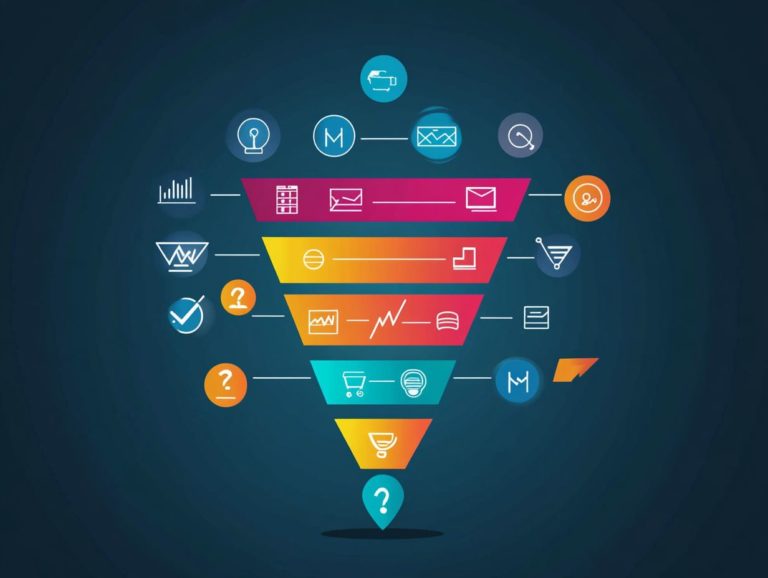Understanding the Importance of Customer Retention
Let's Set Up Your Lead Generation Strategy
Fill out the form below, and our team will get in touch with you to create a tailored solution for your business.
In today s competitive market, customer retention is more crucial than ever. It’s not just about attracting new clients; it’s about nurturing existing relationships to cultivate loyalty.
This article explores customer retention and its significant impact on your business. You ll learn how it affects your success and the costs of losing clients, as well as the importance of customer success.
Discover effective strategies to enhance retention, learn about key metrics for tracking your progress, and explore real-life case studies showcasing successful approaches in retention marketing.
Dive in as you uncover the secrets to keeping your customers coming back for more.
Contents
- Key Takeaways:
- What is Customer Retention?
- The Impact of Customer Retention on Business
- Let's Set Up Your Lead Generation Strategy
- Strategies for Improving Customer Retention
- Let's Set Up Your Lead Generation Strategy
- Measuring and Tracking Customer Retention
- Case Studies: Successful Customer Retention Strategies
- Let's Set Up Your Lead Generation Strategy
- Frequently Asked Questions
- What is customer retention and why is it important?
- How does customer retention impact a business’s bottom line?
- What strategies can businesses use to improve customer retention?
- What are the consequences of not prioritizing customer retention?
- How can understanding customer retention benefit a business?
- What role does customer satisfaction play in customer retention?
Key Takeaways:

- Customer retention means keeping existing customers and building long-term relationships with them instead of constantly acquiring new ones.
- A strong customer retention strategy can greatly benefit a business by increasing customer loyalty, reducing costs, and driving revenue growth.
- To improve customer retention, focus on building strong relationships, providing exceptional customer service, and implementing loyalty programs to reward and retain customers.
What is Customer Retention?
Customer retention means keeping your current customers happy and involved, ultimately nurturing their loyalty and driving the growth of your business. This requires understanding the customer journey, addressing any complaints that arise, and consistently delivering exceptional service at every stage of the sales process.
In a competitive market, focusing on retention strategies can significantly influence your bottom line by reducing churn, enhancing customer satisfaction, and fostering brand loyalty.
Defining the Concept
At its core, customer retention involves the strategies and practices you employ to keep your customers engaged. This concept revolves around several foundational elements, emphasizing customer experience and the critical role of customer success teams.
For example, effective training programs for your customer success teams can help them proactively tackle customer concerns, ensuring smooth interactions at every stage of the buyer’s journey. Take Zappos as a prime example; their exceptional customer service not only fosters loyalty but also encourages repeat purchases.
Deepen your relationships with customers by executing targeted outreach initiatives, such as personalized follow-ups or exclusive promotions. This makes them feel valued and understood. By weaving these practices into your business strategy, you’ll boost your retention rates and cultivate a loyal community around your brand.
The Impact of Customer Retention on Business
The impact of customer retention on your business is profound, shaping both your revenue and market position. When you excel at retaining customers, you often experience a higher retention rate, leading to greater loyalty and sustainable growth.
By leveraging customer insights and adopting cost-effective strategies, you can enhance your customer relationships and pave the way for long-term success through better resource allocation.
Benefits for Companies
Investing in customer retention offers significant benefits, such as heightened customer loyalty, increased satisfaction, and accelerated business growth.
This strategic approach deepens your relationships with existing clients and invites valuable feedback to enhance your products and services. By prioritizing customer retention, you can allocate your marketing budget more effectively, focusing funds on nurturing current relationships instead of chasing new customers.
Achieving higher levels of customer retention leads to a greater lifetime value for each client, ultimately boosting profitability. These advantages create a ripple effect, improving your brand reputation and increasing referral rates, which further solidify your market position.
Let's Set Up Your Lead Generation Strategy
Fill out the form below, and our team will get in touch with you to create a tailored solution for your business.
Costs of Losing Customers

The costs of losing customers can be staggering. This impacts not just your bottom line but also your reputation in the market, leading to diminished customer trust.
When a business struggles to retain its clientele, it directly faces revenue loss. Each departure translates to fewer sales and a diminished cash flow.
The ripple effects don’t stop there customer retention rates can take a nosedive if dissatisfied customers start airing their grievances. Negative perceptions born from these complaints can tarnish your brand’s image, making potential new customers think twice before engaging with your company.
That s why implementing effective retention strategies is crucial. They help you avoid financial losses and foster a loyal customer base that amplifies positive word-of-mouth, ultimately driving long-term success.
Strategies for Improving Customer Retention
Improving customer retention requires a varied method that emphasizes strategies designed to cultivate strong relationships, deliver exceptional service, and elevate customer support. By prioritizing these elements, you can create a returning customer base that feels valued and understood.
Building Strong Relationships
Building strong relationships with customers is essential for enhancing retention rates and cultivating a loyal customer base.
In today s fiercely competitive landscape, personalizing communication goes beyond mere transactional exchanges; it means knowing what each customer likes and needs. By actively listening and engaging with them, you can tailor your messaging and offerings. This ensures customers feel valued and understood.
This direct approach fosters meaningful connections, transforming routine interactions into genuine conversations. Consistent engagement is equally vital, as regular communication keeps interest and loyalty alive over time.
Nurturing these relationships requires ongoing conversation, enabling you to adapt and evolve alongside your customers.
Providing Excellent Customer Service
Providing excellent customer service isn t just a nice-to-have; it s the backbone of effective retention management. It plays a direct role in your customers’ satisfaction.
When you prioritize exceptional service, you cultivate an atmosphere where customers feel genuinely valued and heard.
A recent study shows that 70% of consumers are willing to spend more with a company that boasts a stellar customer service reputation. Timely responses to complaints are vital; in fact, 51% of customers expect a reply within an hour.
Taking a proactive approach like reaching out to customers before issues arise fosters trust and loyalty. Look at companies like Zappos, celebrated for their customer-first philosophy. They report retention rates exceeding 75%, highlighting how investing in quality service can profoundly influence long-term success.
What are you waiting for? Start prioritizing your customers today!
Let's Set Up Your Lead Generation Strategy
Fill out the form below, and our team will get in touch with you to create a tailored solution for your business.
Implementing Loyalty Programs
Implementing a well-structured customer loyalty program can significantly enhance your customer retention rates and boost your revenue.
By offering rewards that genuinely resonate with your customers think exclusive discounts, early access to new products, or unique experiences you can cultivate a deeper emotional connection with your clientele.
Beyond the traditional point systems, innovative strategies like tiered memberships or referral bonuses can entice consumers to remain loyal. Actively gathering and analyzing customer feedback provides invaluable insights into which aspects of your loyalty program are hitting the mark.
This allows you to continuously adapt and refine your offerings while enhancing customer engagement to meet the evolving preferences and expectations of your audience. Don t miss out on the chance to build lasting bonds with your customers!
Measuring and Tracking Customer Retention

Measuring and tracking customer retention is crucial for grasping the effectiveness of your retention strategies. It also reveals invaluable insights about your customers that can drive your business forward.
Key Metrics to Monitor
Key metrics such as customer retention rate, churn rate, and customer lifetime value are vital for you if you re looking to enhance retention performance and optimize your marketing strategy.
Understanding how to calculate these metrics is crucial. They provide invaluable insights into customer behavior and preferences. For example, when you analyze churn rate, which is the percentage of customers who stop using a service during a specific timeframe, it helps you uncover the specific reasons behind customer disengagement. This allows you to tailor your retention strategies more effectively.
Customer lifetime value, defined as the total revenue a business can expect from a single customer over their entire relationship, offers a glimpse into the future. It projects how much revenue a customer will generate, guiding your investments in personalized marketing efforts.
By segmenting your customers based on their behavior and value through customer segmentation, you can create exciting initiatives that truly connect with your customers, building customer loyalty and driving long-term success!
Case Studies: Successful Customer Retention Strategies
By examining case studies of successful customer retention strategies, you uncover valuable insights that can propel your business growth and foster a strong sense of customer advocacy.
Real-Life Examples of Effective Retention Strategies
Real-life examples clearly demonstrate how you can leverage customer feedback and retention marketing to strengthen your relationships and optimize your resources.
Take companies like Starbucks and Amazon, for instance. They have expertly tapped into customer insights to design tailored marketing campaigns and loyalty programs that resonate.
Starbucks utilizes its mobile app not just for convenient ordering, but also as a means to gather valuable feedback. This allows them to provide personalized offers that align with individual preferences.
Meanwhile, Amazon continually fine-tunes its user experience based on reviews and feedback. This adaptive strategy nurtures a deeper connection with its customers. It not only boosts customer loyalty but also drives increased sales, enabling businesses like yours to effectively meet the ever-evolving needs of your audience.
Let's Set Up Your Lead Generation Strategy
Fill out the form below, and our team will get in touch with you to create a tailored solution for your business.
Frequently Asked Questions
What is customer retention and why is it important?

Customer retention refers to the ability of a business to retain its existing customers and keep them coming back for repeat purchases. It is important because it leads to a higher customer lifetime value, reduces customer acquisition costs, and helps to build a loyal customer base.
How does customer retention impact a business’s bottom line?
Customer retention directly impacts a business’s bottom line through increased revenue and profits. By retaining customers, businesses can reduce the costs associated with acquiring new customers and increase sales through repeat purchases and referrals.
What strategies can businesses use to improve customer retention?
Some strategies for improving customer retention include providing exceptional customer service, building strong relationships with customers, offering loyalty programs and incentives, listening to customer feedback and addressing concerns, and consistently delivering high-quality products or services.
What are the consequences of not prioritizing customer retention?
If a business does not prioritize customer retention, it may struggle to maintain a steady stream of revenue and could potentially lose market share to competitors. It may also incur higher marketing costs and damage its reputation if customers have negative experiences.
How can understanding customer retention benefit a business?
Understanding customer retention can benefit a business in several ways. It helps identify areas for improvement in customer experience or product offerings, increases customer satisfaction and loyalty, and ultimately drives long-term growth and success.
What role does customer satisfaction play in customer retention?
Customer satisfaction is a crucial factor in customer retention. Satisfied customers are more likely to continue doing business with a company and recommend it to others. By consistently meeting or exceeding customer expectations, businesses can improve customer satisfaction and increase retention rates.






